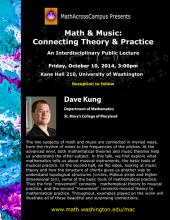The two subjects of math and music are connected in myriad ways, from the rhythm of notes to the frequencies of the pitches. At the advanced level, both mathematical theories and music theories help us understand the other subject. In this talk, we first explore what mathematics tells us about musical instruments, the basic tools of musical practice. In the second half, we flip sides, looking at music theory and how the structure of chords gives us another way to understand topological structures (circles, Möbius strips and higher dimensional tori), some of the basic tools of mathematical practice. Thus the first "movement" connects mathematical theory to musical practice, and the second "movement" connects musical theory to mathematical practice. Throughout, examples played on the violin will illustrate all of these beautiful and surprising connections.
Dave Kung earned a bachelor's degree, master's degree and a Ph.D. all from the University of Wisconsin - Madison. He is currently a professor of mathematics at St. Mary's College of Maryland. His research interests include harmonic analysis, math education and how math relates to music and social justice. He has received many teaching awards and has produced a series of lectures on DVD called "How Music and Mathematics Relate".
